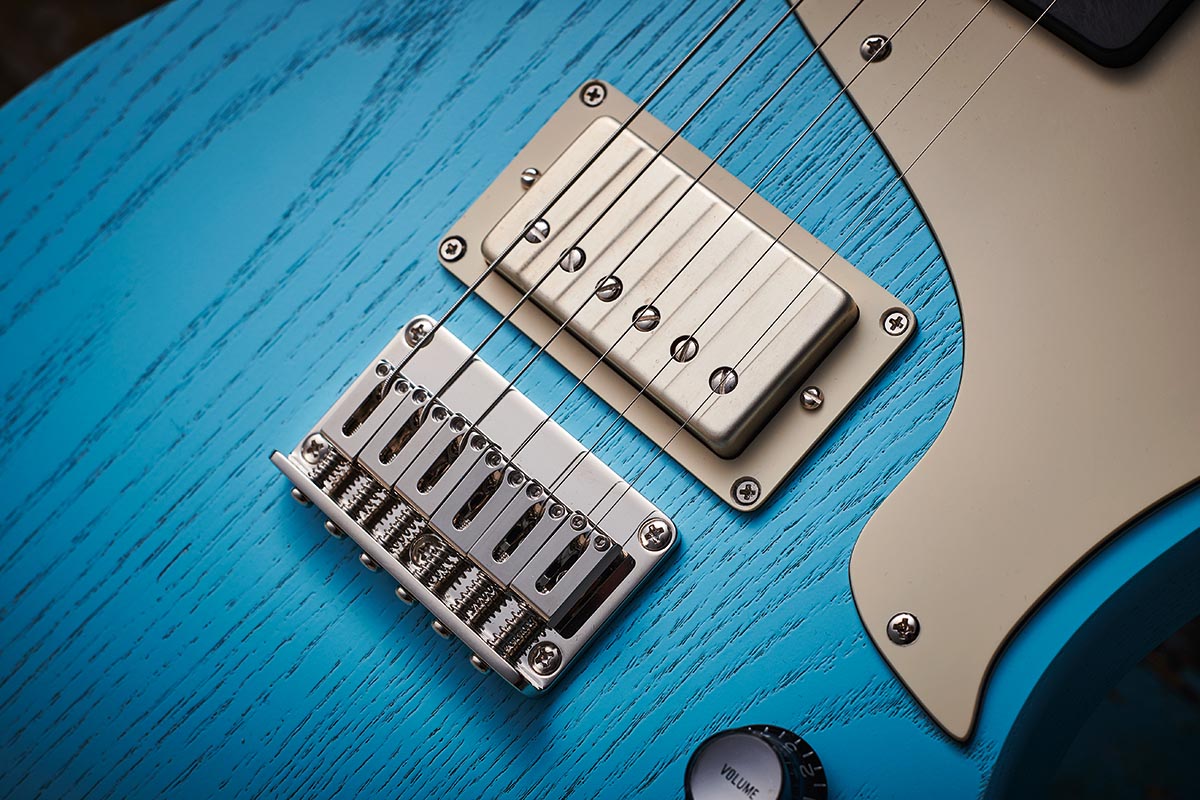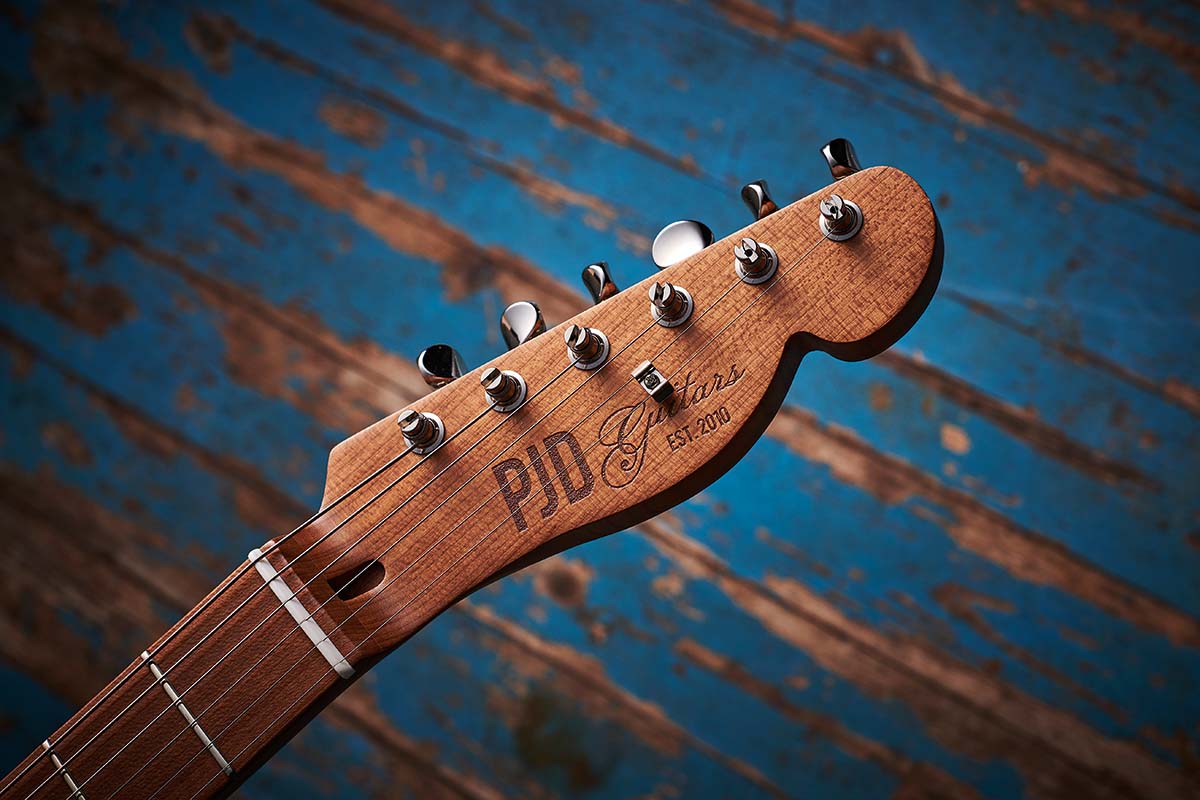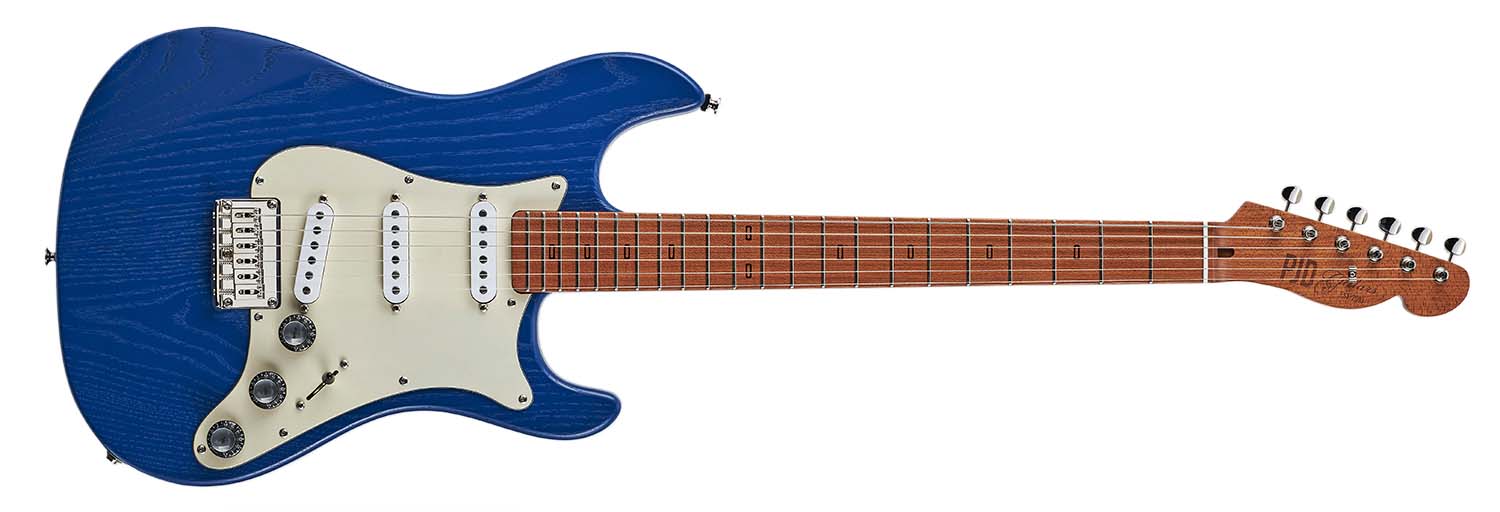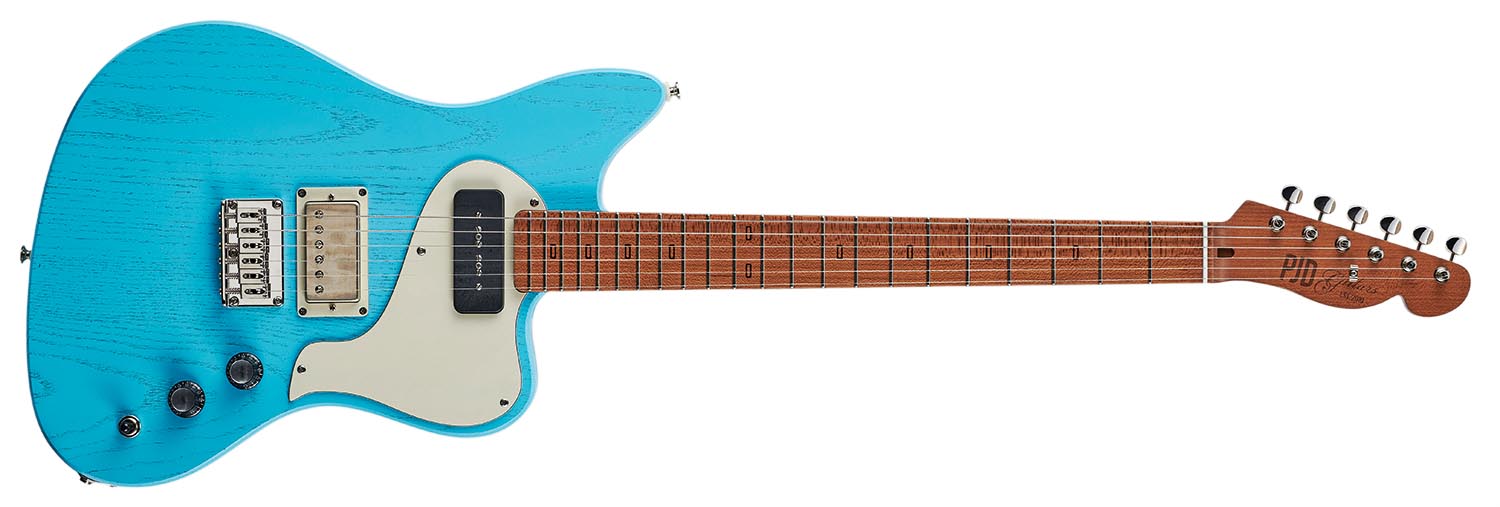Guitar World Verdict
Is British craft important to you? That’s personal choice, but when it’s this good with world-class sounds, these are just very good guitars that purposely mix up influences to create a very valid and lively, vibrant voice. Not tried one? We strongly suggest you do.
Pros
- +
Crisp build.
- +
St John is chambered and lightweight.
- +
Excellent hardware and pickups.
- +
Quality voice, with the St John particularly versatile.
- +
The price.
Cons
- -
No vibrato options.
- -
Standard is another Strat-alike.
- -
Not everyone will like the satin finish.
You can trust Guitar World
Regular Guitarist readers will be aware of York-based guitar maker Leigh Dovey and his PJD team. He’s busy preparing production of a new Cream T electric guitar co-designed with none other than Billy F Gibbons and, without letting any cats out of the bag, there are more collaborations in the pipeline.
In the past 12 months since we last reviewed a PJD, the company has taken on more staff – which now number 12 – and is producing nearly 40 instruments per month. It all seems a long time away from playing an early PJD Woodford, nearly four years ago. Promise isn’t always fulfilled, but in this case it most definitely has been.
Aside from that original Woodford, we’ve mainly focused on the Carey, the central model in the PJD range, but earlier this year PJD announced a paired-back Woodford Standard conceived as a “hand-built guitar that won’t break the bank”. Our other review model here is the latest design, the St John Standard offset – also available in Elite and Limited versions – which joined the line in 2020.

While the Carey mixes up its Les Paul-meets-Telecaster influences, both the Woodford and the St John have more direct (and obvious) inspiration, although the St John especially is noticeably downsized from Fender’s original offset blueprint.
“Yes, the body is quite a bit smaller than a Fender,” says PJD’s founder Leigh Dovey. “I never really got on with the larger body on those offsets. I felt there was too much bulk, which is why I downsized it. Not everyone likes a single-cut guitar like the Carey, and offsets are quite flavour of the month and we’ve seen that in sales: they’ve been doing incredibly well.”
But whatever the style, it’s PJD’s quality and efficient build that really means you’re getting a lot of guitar for your money. Even so, bringing the Woodford Standard in at its planned price of just under a grand proved impossible. “We had to raise the price,” says Leigh. “The original plan of starting at £999 was killing us, basically. It was too low. [So] we’ve gone for regular American ash, not the lighter swamp ash, which helps us achieve that lower price point.”

Both guitars use a two-piece centre-joined construction and have a body depth of 41mm. The Woodford Standard is also solid with light contouring in the usual places but far from heavy at 3.57kg (7.85lb), while the slab-bodied St John – like the other PJDs we’ve played – is chambered, primarily on the bass side, and comes in at 3.18kg (7lb). It’s heavier than our reference Carey Standard, which has slightly more chambering and weighs just 2.63kg (5.79lb).
All the latest guitar news, interviews, lessons, reviews, deals and more, direct to your inbox!
Both guitars have PJD’s quarter-sawn roasted maple necks; the only difference is a slightly different finish. Both are a satin-y nitro, but as Leigh explains, “because the Woodford has to meet a lower price point we just have a thin nitro, four or five coats, so it leaves an almost open-grain type feel.
Whereas the St John Standard actually has quite a few more processes, sealer coats and stuff, so it gives you a more even finish, but it obviously takes longer.” The difference is subtle at best: both necks feel superb.

Gotoh is the hardware of choice and then we get Bare Knuckle Boot Camp on our Woodford, and those or optional Cream T pickups on our St John – you choose. You don’t get a gigbag or case with the start-up Woodford, but a PJD logo’d Hiscox case is standard with the St John.
It’s not just the quality of the component parts that’s impressive, either. There’s a very detailed build here. The neck join, for example, uses Allen key bolts that thread into inserts in the maple neck. There’s no neckplate and the heels are nicely rounded on the treble side.
The satin body finish is also nitro. “It’s a cellulose paint but a very thin mix of paint and lacquer. Then there’s a satin nitro on top of that,” explains Leigh. The characterful stripped grain of the ash is clearly visible and feel-able, and you can’t help thinking – even with the solidbody Woodford, and especially the chambered St John – that it all helps to promote a very lively resonance.

Now, there are plenty of players who won’t get the hardtail bridge, not least, of course, that both the inspirations here typically have vibratos.
“I’ve always been a massive fan of hardtail Strats,” says Leigh. “I’ve owned a couple and I’ve always screwed down the vibrato if it has one. I just think for simplicity it works better. That’s not to say we won’t be offering a vibrato version in the future, but I didn’t want to put it on this guitar.
“I’d very much like to bring a vibrato to the St John, like the Mastery-style – definitely one of those as opposed to the standard Fender-style, which is not exactly reliable. We’ve had requests for vibratos, including Bigsbys for the Carey Elite, and we will be adding them in the future. It’ll definitely happen, but I can’t say when at this stage.”
Both our guitars have cream scratchplates, but because the plastic parts are made in-house you can spec whatever you want. “We offer cream, white, black, tortoiseshell and a pearlescent white. It’s quite a nice thing for a dealer who can offer something different for their shop. We’ve had quite a few requests for mismatched pickguard and pickup rings, too.”

Feel & Sounds
PJD’s necks are one pretty major reason why these guitars have impressed us so far. They look quite vintage-y but actually play hard and fast with the classics.
The fingerboard radius, for example, is lightly compound – 254mm to 305mm (10 to 12 inches) PRS-to-Gibson, if you like – and the Jescar frets are well chosen to provide plenty of height for clean bends, plus the quality of the fretwork, the way the ends are almost burnished, is really first class.
Depth-wise, we go from 21.5mm at the 1st fret to just over 22mm at the 12th. It’s a great shape that is pretty mainstream yet doesn’t feel generic – there’s a character here and the feel of the necks, as we say, is a major reason to try a PJD. Setups on both reflect the detailed build: 1.6mm on the top E and 1.8mm on the low E at the 12th. The bone nuts are beautifully cut, too.

Of course, the functional presentation might well be a bit too utility for some, but having lived and recorded with a Carey Standard during those endless lockdown months and finally been able to gig it, there’s little doubt these are players’ guitars, pure and simple.
That strong vibrant acoustic voice is just lapped up by the Woodford’s Bare Knuckle Boot Camp Old Guard single coils – this is classy ‘Strat’ that happily sits alongside modern bolt-on royalty, such as PRS’s Silver Sky, for example, despite it being virtually half the price. It’s the quality of the sound that is so impressive, with woody depth at the neck, plenty of smash in terms of the attack but certainly not overly bright.
There is, then, quite a contrast at the bridge, which without a tone control might be very vintage-y but does veer on the thin side. Then there’s the middle pickup, which has a definite third character, and neither mix disappoints. As we say, no bells or whistles, but this really is a quality voice.

The St John obviously has a different character, but it’s still underpinned by this lively build and, like our Carey Standard, proves extremely versatile-sounding with the minimum of fuss. Leigh’s not a fan of coil-splits on humbuckers so you don’t get one here, but that’s a simple DIY mod as the Cream T Eliminator has a four-conductor hook-up cable (see Under The Hood).
As we’ve noted before, the neck P-90 and this construction easily recalls a jazz-style semi – use your volume and tone to shade that and players working in those classic jazz/blues territories might need little else.
But the humbucker here provides viable contrast taking us from a clean, quite bright and a little honky hot PAF to driven classic rock and rootsy Americana rhythm sounds and bright-edged leads. But the resonance adds to the sense of power if you need it; it sounds fractionally more ‘solid’ than our Carey Standard, a little more direct with a touch more sizzle from its bridge pickup.
The only negative we can find is the low-contrast translucent white side-dots whereas our Carey Standard reference has black dots, which we prefer.
Verdict
Neither guitar here is quite as original as PJD’s Carey, and their inspirations are hardly unique in today’s market. The palette of sounds from the Woodford is very familiar – more so than the original twin-P-90 version or the new Elite – but when it’s done with this quality-to-price ratio it’s perfectly valid. We’ve played many boutique ‘Strats’ that cost an awful lot more and bring little extra to the table.
The St John jumps on the offset trend, but the combination of the lightweight build and hugely viable pickup combo don’t limit the guitar in the least; it’s a different-shaped take on the Carey recipe. The necks on both are superb, mixing the flatter Gibson/PRS fingerboard radius with a Fender-y feel, and are frankly real boutique in quality.
Specs

PJD Woodford Standard
- PRICE: £1,250
- ORIGIN: UK
- TYPE: Double-cutaway, solidbody hardtail electric
- BODY: 2-piece American ash
- NECK: Quarter-sawn roasted figured maple, standard C profile, bolt-on
- SCALE LENGTH: 648mm (25.5”)
- NUT/WIDTH: Bone/42.7mm
- FINGERBOARD: Roasted maple, rectangular black acrylic inlays, compound 254-305mm (10‑12”) radius
- FRETS: 22, medium (Jescar FW55090)
- HARDWARE: Gotoh SB-5115-001 Strat-style hardtail bridge with block steel saddles and through-body stringing, Gotoh SD-91 vintage-style split-post tuners – nickel-plated
- STRING SPACING, BRIDGE: 53mm
- ELECTRICS: Bare Knuckle Boot Camp Old Guard single coils, 5-way toggle pickup selector switch, master volume and tone controls
- WEIGHT (kg/lb): 3.57/7.85
- OPTIONS: PJD Hiscox hard case costs £160. HSS option. Scratchplate colour
- RANGE OPTIONS: PJD’s core guitar is the Carey in Standard (£1,899), Elite (from £2,399), Ltd Ed (from £2,699) and Custom (from £3,299) styles
- LEFT-HANDERS: To order, same price
- FINISHES: Peacock Blue from 11-colour choice – thin satin nitrocellulose to both body and neck

- PRICE: £1,899 (inc case)
- ORIGIN: UK
- TYPE: Double-cutaway, offset chambered body hardtail electric
- BODY: 2-piece American ash (chambered)
- NECK: Quarter-sawn roasted figured maple, standard C profile, bolt-on
- SCALE LENGTH: 648mm (25.5”)
- NUT/WIDTH: Bone/42.7mm
- FINGERBOARD: Roasted maple, rectangular black acrylic inlays, compound 254-305mm (10-12”) radius
- FRETS: 22, medium (Jescar FW55090)
- HARDWARE: Gotoh SB-5115-001 Strat-style hardtail bridge with block steel saddles and through-body stringing, Gotoh SD-91 vintage-style split-post tuners – nickel-plated STRING SPACING, BRIDGE: 53mm
- ELECTRICS: Cream T Eliminator humbucker (bridge) and P-90 soapbar single coil (neck), 3-way toggle pickup selector switch, master volume and tone controls
- WEIGHT (kg/lb): 3.18/7
- OPTIONS: F-hole, Bare Knuckle Boot Camp Old Guard humbucker/P-90. Choice of pickguard and pickup mounting ring colours
- RANGE OPTIONS: St John Elite (£2,399) adds figured (quilt/flame) maple top with a range of top colours over natural back and sides. St John Ltd (£2,699) adds chambered mahogany back to the Elite – both with Bare Knuckle/Cream T pickups
- LEFT-HANDERS: To order, same price
- FINISHES: Trans Bright Blue (as reviewed), Trans Black, Trans White, Natural, Candy Floss Pink – thin satin nitrocellulose to both body and neck
- CONTACT: PJD Guitars

Dave Burrluck is one of the world’s most experienced guitar journalists, who started writing back in the '80s for International Musician and Recording World, co-founded The Guitar Magazine and has been the Gear Reviews Editor of Guitarist magazine for the past two decades. Along the way, Dave has been the sole author of The PRS Guitar Book and The Player's Guide to Guitar Maintenance as well as contributing to numerous other books on the electric guitar. Dave is an active gigging and recording musician and still finds time to make, repair and mod guitars, not least for Guitarist’s The Mod Squad.

